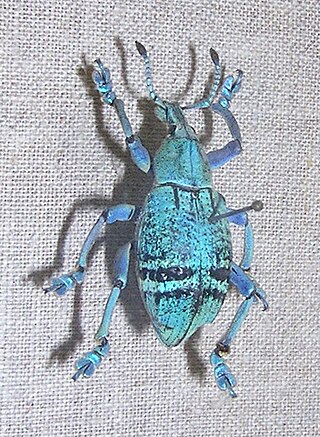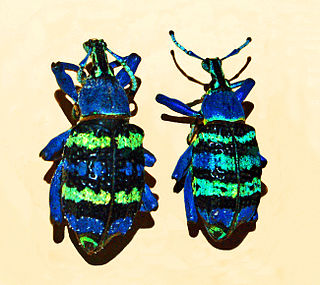
Blue is one of the three primary colours in the RYB colour model, as well as in the RGB (additive) colour model. It lies between violet and cyan on the spectrum of visible light. The eye perceives blue when observing light with a dominant wavelength between approximately 450 and 495 nanometres. Most blues contain a slight mixture of other colours; azure contains some green, while ultramarine contains some violet. The clear daytime sky and the deep sea appear blue because of an optical effect known as Rayleigh scattering. An optical effect called Tyndall effect explains blue eyes. Distant objects appear more blue because of another optical effect called aerial perspective.

Chroma key compositing, or chroma keying, is a visual-effects and post-production technique for compositing (layering) two images or video streams together based on colour hues. The technique has been used in many fields to remove a background from the subject of a photo or video – particularly the newscasting, motion picture, and video game industries. A colour range in the foreground footage is made transparent, allowing separately filmed background footage or a static image to be inserted into the scene. The chroma keying technique is commonly used in video production and post-production. This technique is also referred to as colour keying, colour-separation overlay, or by various terms for specific colour-related variants such as green screen or blue screen; chroma keying can be done with backgrounds of any colour that are uniform and distinct, but green and blue backgrounds are more commonly used because they differ most distinctly in hue from any human skin colour. No part of the subject being filmed or photographed may duplicate the colour used as the backing, or the part may be erroneously identified as part of the backing.

Geoffroy's cat is a small wild cat native to the southern and central regions of South America. It is about the size of a domestic cat. It is listed as Least Concern on the IUCN Red List because it is widespread and abundant over most of its range.

Blue-green is the color that is between green and blue. It belongs to the cyan family of colors.

The white-headed marmoset, also known as the tufted-ear marmoset, Geoffroy's marmoset, or Geoffrey's marmoset, is a marmoset endemic to forests in eastern Brazil, where it is native to Bahia, Espírito Santo, and Minas Gerais, and introduced to Santa Catarina. It is known as the sagüi or sauim in Brazil. Its diet consists of fruits, insects, and the gum of trees.

Geoffroy's spider monkey, also known as the black-handed spider monkey or the Central American spider monkey is a species of spider monkey, a type of New World monkey, from Central America, parts of Mexico and possibly a small portion of Colombia. There are at least five subspecies. Some primatologists classify the black-headed spider monkey, found in Panama, Colombia, and Ecuador as the same species as Geoffroy's spider monkey.

Nyctophilus geoffroyi is a vespertilionid bat, a flying nocturnal mammal found in Australia, The species is relatively common. They have been referred to as the lesser long-eared bat.

The rufous-vented ground cuckoo is a Vulnerable species of cuckoo in the tribe Neomorphini of subfamily Crotophaginae. It is found in Bolivia, Brazil, Colombia, Costa Rica, Ecuador, Nicaragua, Panama, and Peru.

The red-cheeked parrot is a species of parrot in the family Psittaculidae found in Indonesia, Papua New Guinea and the tip of northern Australia. There are 17 subspecies currently recognized. It is a stocky short-tailed parrot with predominantly green plumage. It exhibits sexual dimorphism; the adult male has red cheeks and a mauve nape and top of head, while the female is duller with a brown head.

Eupholus is a genus of beetle in the family Curculionidae. The genus includes some of the most colourful of the weevils. The colour may serve as a warning to predators that they are distasteful. Most species feed upon yam leaves, some of which are toxic to other animals. The species occur in New Guinea and adjacent islands. This genus was described by French entomologist Jean-Baptiste Alphonse Dechauffour de Boisduval in 1835.

The open brain coral is a brightly colored free-living coral species in the family Merulinidae. It is the only species in the monotypic genus Trachyphyllia and can be found throughout the Indo-Pacific.

Eupholus bennetti is a species of beetle belonging to the family Curculionidae.

Eupholus chevrolati is a species of beetle belonging to the family Curculionidae.

Eupholus magnificus is a species of beetle belonging to the family Curculionidae.

Eupholus schoenherrii is a species of beetle belonging to the family Curculionidae. Eupholus petitii is sometimes included here as a subspecies.

Eupholus petitii is a disputed species of beetle belonging to the family Curculionidae.

Eupholus tupinierii is a species of beetle belonging to the family Curculionidae.

Eupholus azureus is a species of beetles belonging to the family Curculionidae.

Eupholus humeridens is a species of beetle belonging to the family Curculionidae.

Eupholus nickerli is a species of beetle belonging to the family Curculionidae.




















